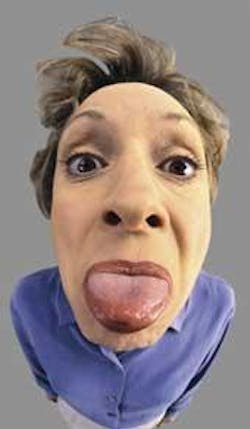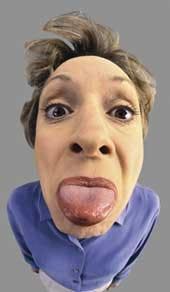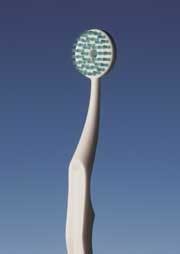New Article
by Donald Antonson, DDS, MEd, Sibel Antonson, DDS, PhD, and Audrey Levitt Galka, DDS
During the last 30 years, consumers have accepted dental professionals' recommendations to clean their teeth and gums. According to a market research firm's findings, Americans spent $1.8 billion on toothpaste in 2000, approximately $715 million on oral-care gum, approximately $740 million on mouthwash and other dental rinses, and $950 million on toothbrushes and dental floss. It is clear that the public is concerned with having good oral hygiene and fighting bad breath. At least they are putting their money where their mouth is.
Should cleaning the tongue also be a part of personal hygiene rituals?
According to Seemann, et al., mechanical tongue cleaning is important to oral hygiene. Volatile sulfur compounds are produced by bacteria on the tongue and are components of oral malodor.
The compounds also are involved in the development of periodontitis and gingivitis. Obviously, it appears that tongue cleaning is important for promoting good oral health, not just bad breath.
Halitosis and its treatment
Millions of people are concerned about halitosis. According to Rosenberg, most adults probably experience bad breath at least some of the time and possibly 25 percent of the population routinely suffer halitosis. He stated that frequent causes of bad breath originate from bacteria in the mouth and that most cases seem to be due to the breakdown of proteins of these bacteria. In people with healthy teeth and gingiva, the odor most likely tends to initiate from the back of the tongue.
It appears that tongue cleaning can reduce oral malodor; however, the effect does seem to be short lived. Since the dental professional is increasingly being called upon to help patients with complaints of bad breath, finding reliable treatment methods for patients is a much-needed service.
Keep in mind that in order to properly treat breath malodor, its cause must be determined. The literature suggests that the main source is the papillae on the back of the tongue, and other factors such as poor oral hygiene, gingival or periodontal problems, defective restorations, ill-fitting dentures, and dry mouth.
According to Loesche and Kazor, "clinical dentistry has responded to the public's demand for treatment of halitosis with the establishment of bad breath clinics." In these clinics, a specific treatment is rendered upon evaluation of the cause of the halitosis. The oral malodor from the overgrowth of proteolytic, anaerobic bacteria on their tongue surfaces can be successfully treated by a regimen that includes tongue brushing, tooth brushing, and possibly the usage of mouthrinses containing various agents such as zinc.
Materials and methods
Local pharmacies and Web sites were scanned to determine the current availability of tongue-cleaning devices. In doing so, various tongue-cleaning devices — including toothbrushes, tongue brushes, tongue scrapers, tongue gels, and various mouthwashes — were found. The objective of the study was to have the patients evaluate a sampling of these tongue-cleaning devices to determine which ones they preferred.
The study consisted of 30 randomly selected adults. Each patient was instructed in the use of three different tongue-cleaning devices: Dr. Wieder's Original Tung-Brush (Peak Enterprises), Breath Rx Gentle Tongue Scraper (Discus Dental), and E-Z SweepTM Tongue Cleaner (E-Z Floss). Patients used these devices for a two-week period, using each device once daily.
The study subjects completed a daily log of each device, indicating the time and duration of use. Each patient rated each device by using a preference questionnaire at the end of the second week. Additionally, they completed a visual analogue scale (VAS) with a scale rated from 0-100; 0 represented "dislike" and 100 "like." The study was conducted at Nova Southeastern University College of Dental Medicine clinics in Ft. Lauderdale, Fla.
After the two-week period with a 100% response rate on the preference questionnaire, the overall VAS evaluation of the products scored out as follows: Dr. Wieder's Original Tung Brush 75 percent, Breath Rx Gentle Tongue Scraper 36 percent, and EZ SweepTM Tongue Scraper 26 percent.
Discussion
The study's results indicate patients prefer a lower profile brush over other choices. This is corroborated by Malcmacher who found that toothbrushes, while helpful, have a high profile (thick head), which limits the ability to get far enough to the back of the tongue without a gagging reflex.
The tongue scrapers were reported by participants to be less effective in cleaning deeper areas of the tongue. A tongue brush and tongue-cleansing gel combination may help control bad breath significantly. Such a combination provides a mechanical and chemical cleansing action.
Over-the-counter mouthwashes can contribute to increased cases of halitosis due to the presence of alcohol, which has a drying effect on the mouth. The drying effect increases the activity of the anaerobic bacteria, thus increasing the volatile sulfur compounds (VSC).
Seemann, et al. did a three-way crossover study with 15 male and 15 female subjects to study the effectiveness of the One-Drop Only Tongue Cleaner (brushes and scrapes), the Tongue-Putzer tongue scraper and a regular toothbrush. The researchers found no significant difference between the groups. The toothbrush (33 percent) reduced oral VSC levels less than the tongue cleaner (42 percent) and the tongue scraper (40 percent). After using the tongue cleaner, reduced VSC values could be detected longer than after using either the tongue scraper or toothbrush.
The authors concluded that the tongue cleaner (a combination brush and scraper) was slightly more effective in reducing oral VSC levels than were a regular toothbrush or tongue scraper. The clinical significance of the study was found to be questionable, since a significant VSC reduction for more than one hour could not be detected. Also, a study performed by Hoshi and van Steenberghe showed that the VSC level after 60 minutes with a regular toothbrush use was not significantly lower.
Future studies need to be completed to verify earlier studies that record the duration of time wherein tongue cleaning is effective. Our preliminary studies with a halimeter suggests that tongue cleaning does reduce sulfur compound levels but no consistent data so far relates to average benefit-time.
Numerous tongue cleaning devices are available for consumers to choose from, but it appears that they prefer a brush-like device which is short in height to allow access to the posterior region of the tongue. Additionally, they felt that a brush provided a better cleaning action than a scraper design.
References
• Rosenberg M. Bad Breath? Blame Biofilms. Emerging Trends in Oral Care. Scientific American 2002; 18-21.
• Seemann R., Kison A., Bizhang M., Zimmer S. Effectiveness of mechanical tongue cleaning on oral levels of volatile sulfur compounds. JADA 2001 September; Vol. 132: 1263-1267.
• Rosenberg M. Bad Breath Research. The British Dental Association Fact File on: Bad Breath (Halitosis). 1996 July; 1-5.
• Loesche W. J., Kazor C. Microbiology and treatment of halitosis. Periodontology 2000 2002; Vol. 28: 256-279
• Malcmacher L. The hygienist's role in halitosis treatment. RDH 1999 March; 19 (3): 50-52, 72.
• Hoshik, van Steenberghe, D. The effect of tongue brushing or toothpaste application on oral malodor reduction. Bad Breath; A multidisciplinary approach. Leuven, Belgium: Leuven University Press; 1996: 255
All three authors are affiliated with Nova Southeastern University's College of Dental Medicine in Ft. Lauderdale, Fla. Donald Antonson, DDS, MEd, is a professor and chair of restorative dentistry. Sibel Antonson, DDS, PhD, is assistant professor and director of dental biomaterials, and Audrey Levitt Galka, DDS, is an assistant professor in the department of restorative dentistry.


